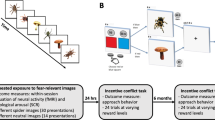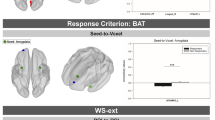Abstract
Neurofunctional mechanisms underlying cognitive behavior therapy (CBT) are still not clearly understood. This functional magnetic resonance imaging (fMRI) study focused on changes in brain activation as a result of one-session CBT in patients suffering from spider phobia. Twenty-six female spider phobics and 25 non-phobic subjects were presented with spider pictures, generally disgust-inducing, generally fear-inducing and affectively neutral scenes in an initial fMRI session. Afterwards, the patients were randomly assigned to either a therapy group (TG) or a waiting list group (WG). The scans were repeated one week after the treatment or after a one-week waiting period. Relative to the non-phobic participants, the patients displayed increased activation in the amygdala and the fusiform gyrus as well as decreased activation in the medial orbitofrontal cortex (OFC) during the first exposure. The therapy effect consisted of increased medial OFC activity in the TG relative to the WG. Further, therapy-related reductions in experienced somatic anxiety symptoms were positively correlated with activation decreases in the amygdala and the insula. We conclude that successful treatment of spider phobia is primarily accompanied by functional changes of the medial OFC. This brain region is crucial for the self-regulation of emotions and the relearning of stimulus-reinforcement associations.

Similar content being viewed by others
References
Becker ES, Hoyer J (1995) Konfrontationsbehandlungen bei Spezifischen Phobien. In: Neudeck P, Wittchen H-U (Hrsg) Konfrontationstherapie bei psychischen Störungen. Hogrefe, Göttingen
Brett M, Penny W, Kiebel S (2004) An introduction to random field theory. In: Frackowiak RSJ, Friston K (ed) Human brain function, 2nd edn. Elsevier, Oxford
Davidson RJ, Pizzagalli D, Nitschke JB, Putnam K (2002) Depression: Perspectives from Affective Neuroscience. Annu Rev Psychol 53:545–74
Dilger S, Straube T, Mentzel HJ, Fitzek C, Reichenbach J, Hecht H, Krieschel S, Gutberlet I, Miltner W (2003) Brain activation to phobia-related pictures in spider phobic humans: an event-related functional magnetic resonance imaging study. Neurosci Lett 248:29–32
Fredrikson M, Annas P, Fischer G, Wik P (1996) Gender and age differences in the prevalence of specific fears and phobias. Behav Res Ther 34:33–39
Fredrikson M, Wik G, Annas P, Ericson K, Stone-Elander S (1995) Functional neuroanatomy of visually elicited simple phobic fear: Additional data and theoretical analysis. Psychophysiology 32:43–48
Fu CHY, McGuire PK (1999) Functional neuroanatomy in psychiatry. Philos Trans R Soc Lond Biol Sci 354:1359–1370
Furmark T, Tillfors M, Marteinsdottir I, Fischer H, Pissiota A, Langstrom B, Fredrikson M (2002). Common changes in cerebral blood flow in patients with social phobia treated with citalopram or cognitive-behavioral therapy. Arch Gen Psychiatry 59:425–433
Gabbard GO (2000) A neurobiologically informed perspective on psychotherapy. Br J Psychiatry 177:117–122
Globisch J, Hamm AO, Esteves F, Öhman A (1999) Fear appears fast: temporal course of startle reflex potentiation in animal fearful subjects. Psychophysiology 36:66–75
Goossens L, Schruers K, Peeters R, Griez E, Sunaert S (2007) Visual perception of phobic stimuli: amygdala activation via an extrageniculostriate pathway? Psychiatry Res Neuroimaging 155:113–120
Johanson A, Gustafson L, Passant U, Risberg J, Smith G, Warkentin S, Tucker D (1998) Brain function in spider phobia. Psychiatry Res Neuroimaging 84:101–111
Johanson A, Risberg J, Tucker DM, Gustafson L (2006) Changes in frontal lobe activity with cognitive therapy for spider phobia. Applied Neuropsychology 13:34–41
Klorman R, Weerts T, Hastings J, Melamed B, Lang P (1974) Psychometric description of some fear-specific questionnaires. Behav Res 5:401–409
Lang PJ, Bradley M, Cuthbert B (1997) International Affective Picture System. Center for Research in Psychophysiology, University of Florida Gainesville
Larson CL, Schaefer HS, Siegle GJ, Jackson CAB, Anderle MJ, Davidson RJ (2006) Fear is fast in phobic individuals: amygdala activation in response to fear-relevant stimuli. Biol Psychiatry 60:410–417
LeDoux J (2002) Synaptic self. How our brains become what we are. Penguin Books, London
Linden DEJ (2006) How psychotherapy changes the brain – the contribution of functional neuroimaging. Mol Psychiatry 11:528–538
Margraf J (1994) Diagnostisches Kurz-Interview bei psychischen Störungen, MiniDIPS. Springer-Verlag, Berlin
O’Doherty J (2001) Abstract reward and punishment representations in the human orbitofrontal cortex. Nat Neurosci 4:95–102
Miltner WH, Trippe RH, Krieschel S, Gutberlet I, Hecht H, Weiss T (2005) Event-related brain potentials and affective responses to threat in spider/snake-phobic and non-phobic subjects. Int J Psychophysiol 57:43–52
Öst LG (1996) One-session group treatment of spider phobia. Behav Res Ther 34:707–715
Öst LG, Ferebee I, Furmark T (1997) One-session group therapy of spider phobia: direct versus indirect treatments. Behav Res Ther 35:721–732
Paquette V, Lévesque J, Mensour B, Leroux JM, Beaudoin G, Bourgouin P, Beauregard M (2003) Change the mind and you change the brain: effects of cognitive behavioral therapy on the neural correlates of spider phobia. Neuroimage 18:401–409
Rauch SL, Savage CR, Alpert NM, Miguel EC, Baer L, Breiter HC (1995) A positron emission tomography study of simple phobic symptom provocation. Arch Gen Psychiatry 52:20–28
Rolls ET (1999) The brain and emotion. University press, Oxford
Schienle A, Schäfer A, Walter B, Stark R, Vaitl D (2005) Brain activation of spider phobics towards disorder-relevant, generally disgust- and fear-inducing pictures. Neurosci Lett 388:1–6
Straube T, Glauer M, Dilger S, Mentzel HJ, Miltner WHR (2006) Effects of cognitive-behavioral therapy on brain activation in specific phobia. Neuroimage 29:125–135
Tzourio-Mazoyer N, Landeau B, Papathanassiou D, Crivello F, Etard O, Delcroix N, Mazoyer B, Joliot M. (2002) Automated anatomical labeling of activations in SPM using a macroscopic anatomical parcellation of the MNI MRI single-subject brain. Neuroimage 15:273–289
Ursu S, Carter CS (2005) Outcome representations, counterfactual comparisons and the human orbitofrontal cortex: implications for neuroimaging studies of decision-making. Cogn Brain Res 23:51–60
Walter B, Blecker C, Kirsch P, Sammer G, Schienle A, Stark R (2003) MARINA: An easy to use tool for the creation of MAsks for Region of INterest Analyses. Neuroimage 19: CD-ROM
Zald DH (2003) The human amygdala and the emotional evaluation of sensory stimuli. Brain Res Rev 41:88–123
Acknowledgements
This work was supported by a grant from the German Research Foundation to A.S.
Author information
Authors and Affiliations
Corresponding author
Rights and permissions
About this article
Cite this article
Schienle, A., Schäfer, A., Hermann, A. et al. Symptom provocation and reduction in patients suffering from spider phobia. Eur Arch Psychiatry Clin Neurosc 257, 486–493 (2007). https://doi.org/10.1007/s00406-007-0754-y
Received:
Accepted:
Published:
Issue Date:
DOI: https://doi.org/10.1007/s00406-007-0754-y




